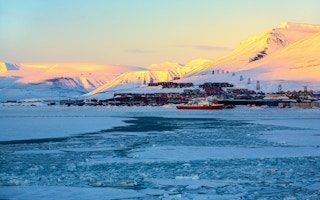Yet another geo-engineering solution to climate change has been proven potentially useless: even if you could paint the Arctic white, the world would still get warmer.
For the second time in months, scientists at the Carnegie Institution for Science in the US have shown that some technological solutions won’t work even in principle, let alone in practice.
Geo-engineering is, for some, the simple technological answer to climate change: if humans have inadvertently warmed the planet’s climate through technological change, then surely they can cool it again intentionally through technological ingenuity.
But Carnegie global ecologist Ken Caldeira and research colleagues − having already demonstrated that piping cold deep waters to the ocean surface would accelerate global warming, rather than reduce it − now report in Environmental Research Letters that changing the reflectivity of the northern hemisphere won’t have the intended consequences either.
Climate machinery
Caldeira, Ivana Cvijanovic, now at the Lawrence Livermore National Laboratory, and Douglas MacMartin, of the California Institute of Technology, decided to consider an aspect of the climate machinery known as albedo. This is a measure of the planet’s reflectivity.
“
Our results indicate that whitening the surface of the Arctic Ocean would not be an effective tool for offsetting the effects of climate change caused by atmospheric greenhouse gases.
Professor Ken Caldeira, Carnegie global ecologist
It works like this: dark colours, such as blue oceans and green rainforests, absorb more sunlight, while white and pale surfaces – snow caps and ice sheets, for instance – reflect most sunlight.
So the Arctic and Antarctic keep cold simply by staying frozen. But any consistent thawing pattern will make an icy region warmer, at an increasing rate.
This is happening at measurable speed, in the northern hemisphere. “By the middle of the century, the Arctic Ocean is predicted to be ice-free during part of the year,” Dr Cvijanovic says. “This could create substantial ecological problems in the Arctic, including habitat range and loss of biodiversity.
“However, the problem is not only local. A number of studies have indicated that Arctic sea ice loss can affect weather patterns across the northern mid-latitudes, including Europe, most of North America and much of Asia.”
So it would make sense to keep the Arctic cold and white − perhaps by filling the ocean with floating reflective grains, or the air above it with tiny bubbles to bounce back the incoming sunlight.
But the Carnegie team decided to work out, with help from computer models, what a whiter Arctic would achieve in a world in which humans went on burning fossil fuels in ever-increasing quantities, in which the atmosphere eventually held four times the carbon dioxide levels recorded at the start of the Industrial Revolution, and in which average planetary temperatures went up by a devastating 10°C.
Cooling effect
The whitening of the Arctic would restore a percentage of the ice – about three-quarters of a square kilometre for every whitened square kilometre. But the cooling effect would be much more modest.
And the return of the ice would not preserve the permafrost – home to colossal quantities of organic carbon that could, if released, become carbon dioxide – or prevent escapes of another potent greenhouse gas, methane.
While it might work to keep a bay or inlet frozen, it would not, in principle, save a frozen ocean, or save the world from catastrophic climate change.
“Simply put, our results indicate that whitening the surface of the Arctic Ocean would not be an effective tool for offsetting the effects of climate change caused by atmospheric greenhouse gases,” Professor Caldeira says.
“Furthermore, it is not clear to me that there is a technologically feasible way of actually doing this. And even if you could do it, the direct negative consequences of reducing the amount of sunlight available to marine ecosystems could be huge.”








